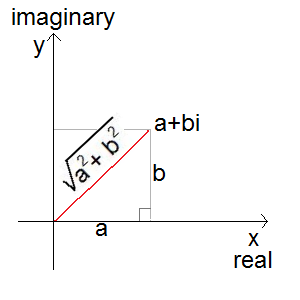
 |
Aleph Zero Home |
Multiplying one complex number by another complex number is a bit more challenging.
But it works out OK as long as we remember that i*i = -1.
If z1 = a + bi and z2 = x + yi then
z1*z2 = (a*x - b*y) + (a*y + b*x)i
See what happens to Penny when every part of her is multiplied by the same complex number. Enter a number and press Go. Reset will return Penny to her original position.
x =
y =
The mapping is z |-> z * (1.5-i)
When we scaled Penny by multiplying by a real number, you should have noticed that if the number was between minus one and one, then Penny got smaller. If the number was greater than one, or smaller than minus one, then Penny got larger.
The same sort of thing happens when we multiply by a complex number. But how can we tell how big a complex number is? It turns out, that the measure that works, is its distance from the origin.

In this picture, the distance from the origin is given by the length of the red line. We can calculate this using Pythagoras’ theorem.
This is the size of the complex number a + bi, and is called its modulus, written |a + bi|.
Suppose our mapping is given by z |-> k*z.
If |k| is greater than one then the image will expand, and if it is less than one it will contract. So, if you apply the same map over and over again, Penny will move in an expanding or contracting spiral.
If |k| is exactly one, then Penny will stay the same size, and just rotate around the origin. Try it out with k = 0.8 + 0.6i
Next Division of complex numbers.